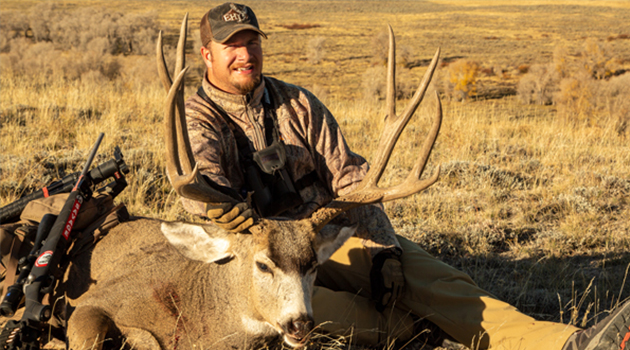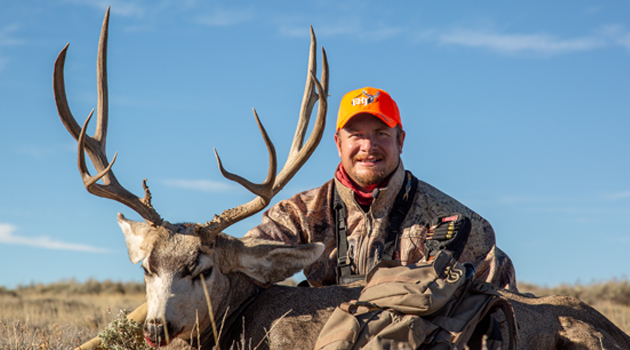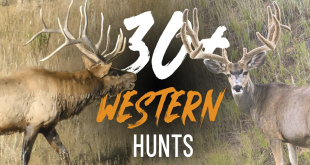
Guest Author: Dalton Buller
Lower elevations are often overlooked when planning a hunt, but they hold potential for mature deer. Lower elevations can range anywhere from 4,000 feet to 7,000 feet but it all depends on where you choose to hunt. You can get far enough off the beaten path to hunt big deer effectively. You just have to work a little harder and hunt a little smarter to find a mature buck. However, you don’t have to stay on the mountain to be able to hunt all day. The downside is that you may have to start earlier and walk in the dark for your success rate to go up.
Time is often short for many of us and is one of the biggest factors determining success on a lower elevation hunt, whether it’s how much time you have between sunrise and sunset, how long you have to put together a stalk, or whether you have days or hours to hunt. Time determines where you hunt, how far or if you can pack in and camp on the mountain for a couple of nights. There is no doubt that the high country holds the some of the best potential for killing a mature buck, but what if there is no time to get out for more than a couple of days to hunt for a mature mule deer?
The idea of hunting the high country has been brought up more and more in recent years. Hunters who are lucky enough to get the time off to pack in for a few days are often greatly rewarded. As a college student, I find myself trying to get every opportunity I can to pack into the backcountry, but it doesn’t always work out that way. Busy lives often force hunters into quickly planned and spontaneous hunts. Hunting on short notice can be challenging but there are ways to be successful.
You are going to be more tired than you normally would be on a high country backpack hunt. You have to start earlier in the morning hiking in the dark to get to the spot that you want to be glassing before sunrise. In the higher elevation hunts, you have the luxury of stepping out of your tent and being very close to great glassing spots. With my limited schedule, I find myself getting up at 3 a.m. on a Saturday to get to my hunting area with enough time to hike in with the cover of darkness. I try to use the same trails over and over so I will only bump deer once in the dark and I try to never cross the areas I will be glassing.
On most of my weekend hunts, I only have one night that I have to stay so I’m not too picky about my camping spots. I usually pick the spot that is the closest to where I like to start hiking, sometimes even at the trailhead itself in my truck if I have to. This can add precious hours of sleep, because I don’t have to drive to the trailhead from camp.
Managing your time effectively can improve how the hunt goes, as well as keep from you from being discouraged by unfavorable weather conditions. Unfortunately, the weather doesn’t consult our hunting schedules before dropping 6” of snow. Use the weather conditions to your advantage. Bad weather doesn’t mean you have to pack up and leave or cancel my hunt, just get out there! Use the rough weather in your favor. The deer don’t like to be out in it any more than you do but they don’t want to starve either.
What it really comes down to is being patient enough to wait out the storms. Once the harsh mountain weather stops, opportunities to find big bucks rise. The deer become more active and they see it as a gap to get up and feed while there is a break in the storm. The key is being there when the weather breaks. We call this a sucker hole when there is just a long enough gap to catch a big deer out of his bed and make a move on him. Just head out prepared for the rough weather, otherwise you might just be the sucker that gets stranded or hurt. Hunting deer in bad weather is one of those rare opportunities to catch a mature deer in the open that wouldn’t normally be out during the day or feeding in the middle of the afternoon. However, make sure you also head out mentally prepared for the cold wet weather or even to stay out overnight if necessary.
When the first big snowstorm hits the higher elevations the deer that spend all summer in the high country start to head down to lower elevations. This offers great opportunities for the hunter who has limited time to be in the field! This doesn’t mean that they are going to be right off the side of the road just waiting for you to drive by and kill them (stranger things have happened), but it does make it easier to hunt them on short notice. This can also be an effective tactic when time for summer scouting wasn’t available. It’s not unusual for trucks to be driving back and forth on the roads waiting for something to cross. Road hunting doesn’t usually produce big bucks but we all know that lucky guy. The best thing that you can do is to get out of your truck. You don’t have to hike five miles but get far enough off the road to where it is hard to see it or hear vehicles. The deer will hang out in secluded pockets where they can’t be seen from any roads.
When using this tactic you won’t be able to glass like you do in the high country and you may have to walk more than you are used to. Walking in bad weather can seem difficult when snow is pelting your face or the fog is so dense you can’t see ten yards in front of you. But the end result will be worth it when you cut a big buck’s tracks and find him hanging in the open when the weather breaks.
We all know that you can’t always count on the weather to help with a hunt. What if the weather is your typical fall weather, cold in the mornings and evenings and hot during the afternoon? Many of the tactics will stay the same when hunting in these conditions but you will have many more glassing opportunities. In the town where I live, there is a general deer unit only a couple miles from town. The area is covered with sagebrush and numerous deep draws that run the length of the mountain. This area is anywhere from 5,000 to 7,000 feet in elevation and is very difficult to hunt. The deer population is very low as well which makes for a difficult hunt but there are a few mature bucks in the area. I usually hunt this area in the evenings on the weekdays because of its close proximity to home. The key to hunting this type of area is to walk and glass into the pockets of deep sage. There are roads everywhere and most of the guys I see typically just drive around. But you can’t always see everything in this country from the roads. The roads parallel the draws but you can’t actually see down into them because of their depth.
I usually start at the head of the draw with the sun at my back and park my truck out of sight a few hundred yards away. I like to walk on the lower half of the draw and glass every hundred yards. This way I can keep glassing the same spots a couple times from different angles. With six-foot tall sagebrush you need to look from every angle. Big mature bucks know how to hide; they are big for a reason. They know where the best hiding spots are and they stick to them. When I’m glassing, I look for movement or a glimmer from the sun hitting an antler. I always try to cover the same area more than once. You’ll be amazed what you can pick up on if you look over a spot multiple times.
At the end of the season, I can look back and say that I was able to spend a lot of time hunting, even if it wasn’t glassing high country basins for weeks on end. With a little bit of work, patience, and above all the will to hunt, a big mule deer can be had at a lower elevation!
 Eastmans' Official Blog | Mule Deer, Antelope, Elk Hunting and Bowhunting Magazine | Eastmans' Hunting Journals
Eastmans' Official Blog | Mule Deer, Antelope, Elk Hunting and Bowhunting Magazine | Eastmans' Hunting Journals







3 comments
Pingback: High Expectations at Low Elevations - Eastmans' Official Blog | Mule Deer, Antelope, Elk Hunting and Bowhunting Magazine
Pingback: High Expectations at Low Elevations – FreaknHunting.com
Pingback: Off season Bowhunting - Eastmans' Official Blog | Mule Deer, Antelope, Elk Hunting and Bowhunting Magazine | Eastmans' Hunting Journals